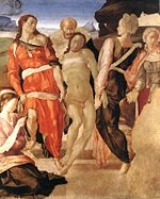
The Entombment
Encyclopedia
The Entombment is an unfinished painting of the placing of the body of Jesus in the garden tomb
, attributed to the Italian Renaissance master Michelangelo Buonarroti and dated to around 1500 or 1501. It is in the National Gallery
in London
, which purchased the work in 1868 from Robert Macpherson
, a Scottish photographer resident in Rome
who had discovered the painting there.
The chronological position of this work has been the source of some dispute, although it is generally considered an early work. Some authorities believe that it may have been executed by one of Michelangelo's pupils from a drawing by the master or was a direct imitation of his workhttp://www.buonarroti.eu/sepoltura_di_cristo_sc_7462.htm.
According to documents discovered in 1981http://www.buonarroti.eu/sepoltura_di_cristo_sc_7462.htm, Michelangelo had been commissioned to paint a panel for the church of Sant'Agostino
in Rome
, but in the end gave back the sum received. It is probable that this work was the "Entombment", which remained unfinished upon Michelangelo's return to Florence
.
The centre of the panel portrays Christ carried to the sepulchre. The bearded elderly man behind him is Joseph of Arimathea
, who gave up his tomb for use as Christ's sepulchre. The figure on the left is probably Saint John, wearing a long orange-red gown, with Mary Magdalene
kneeling at his feet.
The identity of the two figures on the right is uncertain (Nicodemus
, the inner one, and Mary Salome have been proposed). Not present is the figure of the Virgin Mary.
Entombment of Christ
The Entombment redirects here. For other uses, The Entombment The Entombment of Christ, that is to say the burial of Jesus Christ, occurred after his death by crucifixion, when, according to the gospel accounts, he was placed in a new tomb belonging to Joseph of Arimathea.-Biblical account:All four...
, attributed to the Italian Renaissance master Michelangelo Buonarroti and dated to around 1500 or 1501. It is in the National Gallery
National Gallery, London
The National Gallery is an art museum on Trafalgar Square, London, United Kingdom. Founded in 1824, it houses a collection of over 2,300 paintings dating from the mid-13th century to 1900. The gallery is an exempt charity, and a non-departmental public body of the Department for Culture, Media...
in London
London
London is the capital city of :England and the :United Kingdom, the largest metropolitan area in the United Kingdom, and the largest urban zone in the European Union by most measures. Located on the River Thames, London has been a major settlement for two millennia, its history going back to its...
, which purchased the work in 1868 from Robert Macpherson
Robert Turnbull Macpherson
Robert Turnbull Macpherson was a Scottish artist and photographer who worked in Rome, Italy, in the 19th century.- Early life :...
, a Scottish photographer resident in Rome
Rome
Rome is the capital of Italy and the country's largest and most populated city and comune, with over 2.7 million residents in . The city is located in the central-western portion of the Italian Peninsula, on the Tiber River within the Lazio region of Italy.Rome's history spans two and a half...
who had discovered the painting there.
The chronological position of this work has been the source of some dispute, although it is generally considered an early work. Some authorities believe that it may have been executed by one of Michelangelo's pupils from a drawing by the master or was a direct imitation of his workhttp://www.buonarroti.eu/sepoltura_di_cristo_sc_7462.htm.
According to documents discovered in 1981http://www.buonarroti.eu/sepoltura_di_cristo_sc_7462.htm, Michelangelo had been commissioned to paint a panel for the church of Sant'Agostino
Sant'Agostino
Sant'Agostino is a church in Rome, Italy, not far from Piazza Navona. It is one of the first Roman churches built during the Renaissance. The construction was funded by Guillaume d'Estouteville, Archbishop of Rouen and Papal Chancellor. The façade was built in 1483 by Giacomo di Pietrasanta, using...
in Rome
Rome
Rome is the capital of Italy and the country's largest and most populated city and comune, with over 2.7 million residents in . The city is located in the central-western portion of the Italian Peninsula, on the Tiber River within the Lazio region of Italy.Rome's history spans two and a half...
, but in the end gave back the sum received. It is probable that this work was the "Entombment", which remained unfinished upon Michelangelo's return to Florence
Florence
Florence is the capital city of the Italian region of Tuscany and of the province of Florence. It is the most populous city in Tuscany, with approximately 370,000 inhabitants, expanding to over 1.5 million in the metropolitan area....
.
The centre of the panel portrays Christ carried to the sepulchre. The bearded elderly man behind him is Joseph of Arimathea
Joseph of Arimathea
Joseph of Arimathea was, according to the Gospels, the man who donated his own prepared tomb for the burial of Jesus after Jesus' Crucifixion. He is mentioned in all four Gospels.-Gospel references:...
, who gave up his tomb for use as Christ's sepulchre. The figure on the left is probably Saint John, wearing a long orange-red gown, with Mary Magdalene
Mary Magdalene
Mary Magdalene was one of Jesus' most celebrated disciples, and the most important woman disciple in the movement of Jesus. Jesus cleansed her of "seven demons", conventionally interpreted as referring to complex illnesses...
kneeling at his feet.
The identity of the two figures on the right is uncertain (Nicodemus
Nicodemus
Saint Nicodemus was a Pharisee and a member of the Sanhedrin, who, according to the Gospel of John, showed favour to Jesus...
, the inner one, and Mary Salome have been proposed). Not present is the figure of the Virgin Mary.

